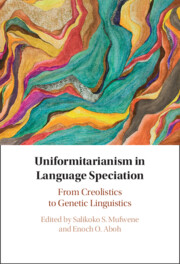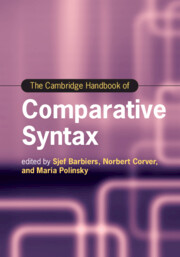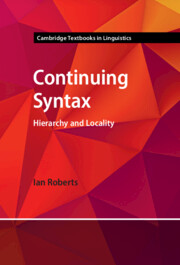Refine search
Actions for selected content:
6584 results in Grammar and Syntax
The Cambridge Handbook of Distributed Morphology
- Morphology after Syntax and Beyond
- Coming soon
-
- Expected online publication date:
- December 2026
- Print publication:
- 31 December 2026
-
- Book
- Export citation
The Cambridge Handbook of Distributed Morphology
- Core Components and the Syntax-Morphology Interface
- Coming soon
-
- Expected online publication date:
- December 2026
- Print publication:
- 31 December 2026
-
- Book
- Export citation
Language Rules!
- Secrets of a Uniquely Human Ability
- Coming soon
-
- Expected online publication date:
- May 2026
- Print publication:
- 31 May 2026
-
- Book
- Export citation
The Cambridge Handbook of the Minimalist Program
- Coming soon
-
- Expected online publication date:
- March 2026
- Print publication:
- 31 March 2026
-
- Book
- Export citation

Beyond Grammar and the Lexicon
- Indicating and Depicting in Sign Language Discourse
- Coming soon
-
- Expected online publication date:
- March 2026
- Print publication:
- 28 February 2026
-
- Book
- Export citation

Comparing Syntax
- An Introduction to Formal Language Typology
- Coming soon
-
- Expected online publication date:
- January 2026
- Print publication:
- 31 December 2025
-
- Textbook
- Export citation

Voice and Argument Structure in Basque
- Coming soon
-
- Expected online publication date:
- January 2026
- Print publication:
- 31 January 2026
-
- Book
- Export citation

The Acquisition of Relativization
- Coming soon
-
- Expected online publication date:
- December 2025
- Print publication:
- 31 December 2025
-
- Book
- Export citation

Uniformitarianism in Language Speciation
- From Creolistics to Genetic Linguistics
- Coming soon
-
- Expected online publication date:
- December 2025
- Print publication:
- 18 December 2025
-
- Book
- Export citation
Syntactic Variation from Individuals to Populations
- Language as a Complex System
- Coming soon
-
- Expected online publication date:
- December 2025
- Print publication:
- 31 January 2026
-
- Element
- Export citation

The Cambridge Handbook of Comparative Syntax
- Coming soon
-
- Expected online publication date:
- December 2025
- Print publication:
- 04 September 2025
-
- Book
- Export citation

Linguistic Illusions
- A Case Study on Agreement Attraction
-
- Published online:
- 30 October 2025
- Print publication:
- 02 October 2025

Continuing Syntax
- Hierarchy and Locality
-
- Published online:
- 03 October 2025
- Print publication:
- 25 September 2025
-
- Textbook
- Export citation
7 - A Puzzle for Both Accounts
-
- Book:
- Linguistic Illusions
- Published online:
- 30 October 2025
- Print publication:
- 02 October 2025, pp 106-121
-
- Chapter
- Export citation
Acknowledgments
-
- Book:
- Linguistic Illusions
- Published online:
- 30 October 2025
- Print publication:
- 02 October 2025, pp xv-xvi
-
- Chapter
- Export citation
Tables
-
- Book:
- Linguistic Illusions
- Published online:
- 30 October 2025
- Print publication:
- 02 October 2025, pp xi-xii
-
- Chapter
- Export citation
3 - The Case of Agreement Attraction
-
- Book:
- Linguistic Illusions
- Published online:
- 30 October 2025
- Print publication:
- 02 October 2025, pp 35-61
-
- Chapter
- Export citation
2 - A Brief Survey of Linguistic Illusions
-
- Book:
- Linguistic Illusions
- Published online:
- 30 October 2025
- Print publication:
- 02 October 2025, pp 13-34
-
- Chapter
- Export citation
8 - Taking Stock
-
- Book:
- Linguistic Illusions
- Published online:
- 30 October 2025
- Print publication:
- 02 October 2025, pp 122-135
-
- Chapter
- Export citation
Dedication
-
- Book:
- Linguistic Illusions
- Published online:
- 30 October 2025
- Print publication:
- 02 October 2025, pp v-vi
-
- Chapter
- Export citation
